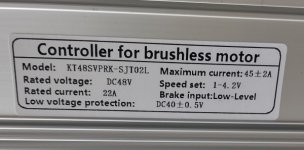I was riding along using throttle, and I noticed that if I completely let the throttle go back to 0 to slow down, that the motor would coast. However if I slowly let the throttle back down, I noticed the motor would hold back. Regeneration? Anyway all of the sudden the motor really vibrated to a stop.
I cut the power off and I noticed that the motor has a lot of drag, until I disconnected the phase wire from the controller. So I reinstalled the square wave and all is good.
How could the motor hold me back? Its a new controller and I didn't set up regeneration, if thats what it is.
Some controllers have what is called Slip Regen (there's other names for it as well, that I don't recall, most of them poor translations from Chinese). That behaves as you describe, where throttling somewhat rapidly down to zero lets you coast, but slowly down causes it to attempt to just follow the throttle-commanded speed. So if you have a max available speed of say, 20MPH, and you are at 50% throttle, it'll be trying to push you along at 10MPH. If you lower throttle to say, 10%, it'll try to actively slow you to 2MPH and hold you there. If the throttle is setup to modulate current or power instead of voltage (speed) then the results are a bit different, but the intended behavior is the same.
A controller might come preset with many things different than the way you want them to be, so it's important to go thru all the menus of a controller's setup program or display while referencing it's manual (and sometimes the internet to interpret the manual :/ ) and verify every setting is what you want it to be, and save all the changes (even if you don't change anything; sometimes what's displayed in the menus is the default for the setup program but not what the controller is actually set to, until you apply / save what's displayed into the controller).
So it could have been factory setup for slip regen, and for higher currents than your system allowed for, or different cutoff voltages, etc., causing controller failure.
One scenario for regen causing blown FETs (which is probably what's wrong with that controller, given the failure symptom), is if the battery is near full charge and regen causes it to rise in voltage above the BMS's shutoff limit, so it turns off the discharge and charge ports. When that happens and the controller is generating current, there's now nowhere for the current to go, so the voltage suddenly spikes way way up, above what the controller electronics can handle, and FETs fail...usually shorted, stuck on, which is why the motor feels draggy or cogs when connected to the controller, even if the controller is off or disconnected from the battery.
Another scenario is that if the hall/phase combo was not correct, then the regen currents generated, along with the heat already built up in the FETs from having to drive the motor with incorrect timing, could be enough to push the FETs over the edge and fail.
You can test for failed FETs using the info on the ebikes.ca Learn - Troubleshooting page, and buy new FETs to replace the failed ones (or all of the FETs if you prefer) with; typically it's a good idea to replace them with teh same part number as the FETs you're not replacing, so they all behave the same and share current as well as they can.





